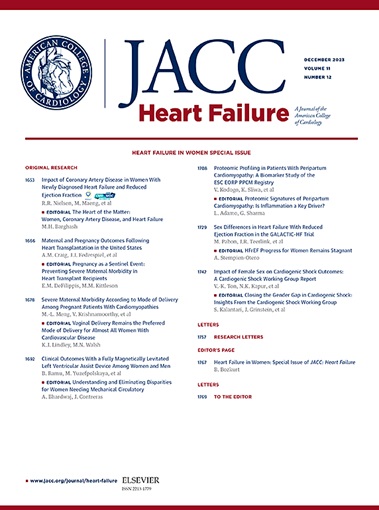Heart-Lung Interactions in HFpEF
IF 10.3
1区 医学
Q1 CARDIAC & CARDIOVASCULAR SYSTEMS
引用次数: 0
Abstract
Background
Patients with heart failure with preserved ejection fraction (HFpEF) are characterized by an exaggerated rise in pulmonary capillary wedge pressure (PCWP) with exercise compared with healthy similar-aged adults. Due to the multisystemic effects of the disease, patients with HFpEF often experience expiratory flow limitation (EFL), thereby perpetuating dynamic hyperinflation (DH) and ventilation at a higher percentage of total lung volume. How lung mechanics and operational lung volume affect central hemodynamics in patients with HFpEF is not fully understood.
Objectives
The authors sought to characterize the association and correlation of DH and EFL on PCWP in adults with HFpEF during exercise.
Methods
A total of 55 patients with HFpEF (71 ± 7 years of age, 70% female) were studied at rest and during 20-W and peak exercise on an upright semirecumbent cycle ergometer. Right atrial and mean pulmonary artery (mPAP) pressures as well as PCWP (via right heart catheterization), oxygen uptake (indirect calorimetry), cardiac output (direct Fick), and ventilation (flow-volume parameters) were measured at each timepoint. DH was defined as an increase in end-expiratory lung volume of ≥150 mL from rest as determined by repeated inspiratory capacity maneuvers.
Results
PCWP was greater in those with DH at 20-W exercise (DH 24 ± 6 mm Hg vs typical 18 ± 6; P = 0.033) and peak exercise (DH 44 ± 9 vs typical 31 ± 6 mm Hg; P = 0.002). The degree of dynamic inflation was modestly, but significantly associated with a greater PCWP at 20-W (r2 = 0.196; P = 0.001) and peak (r2 = 0.204; P < 0.001) exercise, as was mPAP (both P < 0.001).
Conclusions
Patients with HFpEF that dynamically hyperinflate during exercise have greater PCWP as measured with reference to atmospheric pressure. The severity of hyperinflation scaled proportionally to higher exercise PCWP. Our findings suggest that the augmented exercise PCWP in patients with HFpEF may not be entirely attributed to ventricular stiffness, but also a consequence of increased intrathoracic pressure from dysfunctional ventilatory mechanics. (Mechanisms of Exercise Intolerance in Heart Failure With Preserved Ejection Fraction; NCT04068844)
HFpEF的心肺相互作用
背景:与年龄相仿的健康成人相比,具有保留射血分数(HFpEF)的心力衰竭患者在运动时肺毛细血管楔压(PCWP)升高明显。由于该疾病的多系统影响,HFpEF患者经常经历呼气流量限制(EFL),从而使动态恶性充气(DH)和通气在肺总容积中所占的比例更高。肺力学和手术肺容量如何影响HFpEF患者的中央血流动力学尚不完全清楚。目的探讨运动中DH和EFL与HFpEF成人PCWP的相关性。方法55例HFpEF患者(71±7岁,女性70%)在静止状态下、20-W及运动高峰时在直立半卧式循环测力仪上进行测量。在每个时间点测量右心房和平均肺动脉(mPAP)压力以及PCWP(通过右心导管)、摄氧量(间接量热法)、心输出量(直接Fick)和通气量(流量-容量参数)。DH定义为呼气末肺容量从休息时增加≥150ml,通过反复吸气量操作确定。结果20 w运动时DH组的spcwp明显高于正常组(DH 24±6 mm Hg vs正常组18±6 mm Hg;P = 0.033)和运动峰值(DH 44±9 vs典型31±6 mm Hg;P = 0.002)。动态通货膨胀程度适度,但与20 w时较大的PCWP显著相关(r2 = 0.196;P = 0.001)和峰值(r2 = 0.204;P & lt;0.001)运动,mPAP也是如此(P <;0.001)。结论运动时动态充气的HFpEF患者的PCWP相对于大气压有较大的变化。恶性通货膨胀的严重程度与较高的运动PCWP成比例。我们的研究结果表明,HFpEF患者的增强运动PCWP可能不完全归因于心室僵硬,也可能是通气力学功能障碍导致的胸内压力增加的结果。心力衰竭伴射血分数保留的运动不耐受机制;NCT04068844)
本文章由计算机程序翻译,如有差异,请以英文原文为准。
求助全文
约1分钟内获得全文
求助全文
来源期刊

JACC. Heart failure
CARDIAC & CARDIOVASCULAR SYSTEMS-
CiteScore
21.20
自引率
2.30%
发文量
164
期刊介绍:
JACC: Heart Failure publishes crucial findings on the pathophysiology, diagnosis, treatment, and care of heart failure patients. The goal is to enhance understanding through timely scientific communication on disease, clinical trials, outcomes, and therapeutic advances. The Journal fosters interdisciplinary connections with neuroscience, pulmonary medicine, nephrology, electrophysiology, and surgery related to heart failure. It also covers articles on pharmacogenetics, biomarkers, and metabolomics.
 求助内容:
求助内容: 应助结果提醒方式:
应助结果提醒方式:


